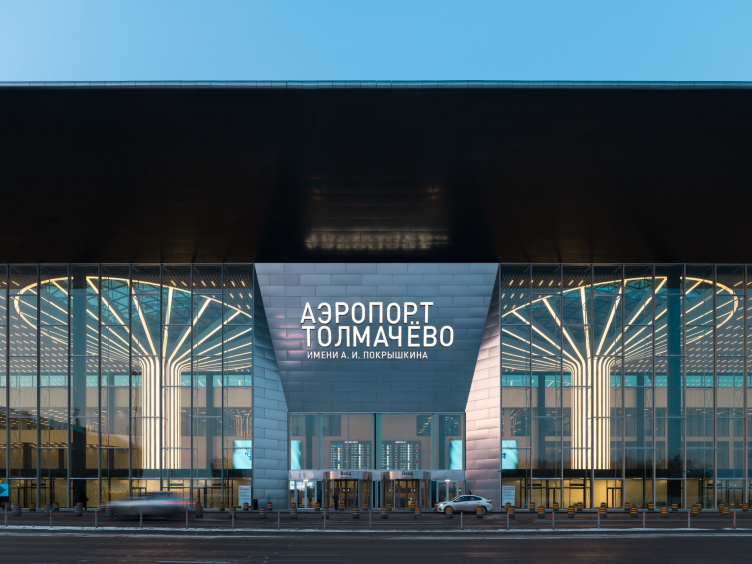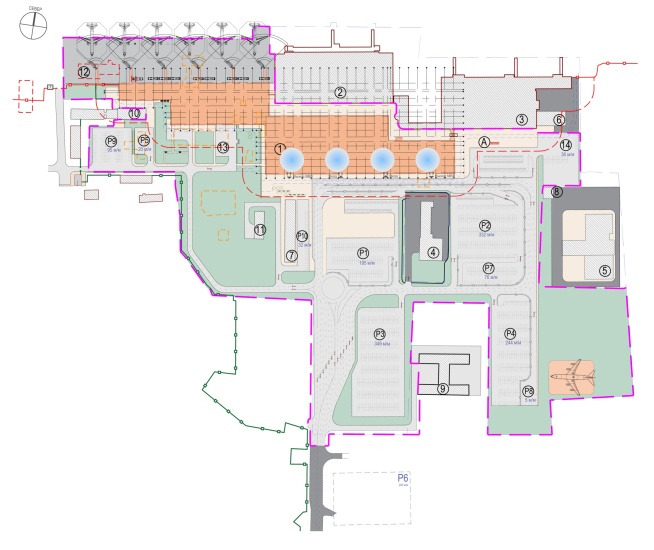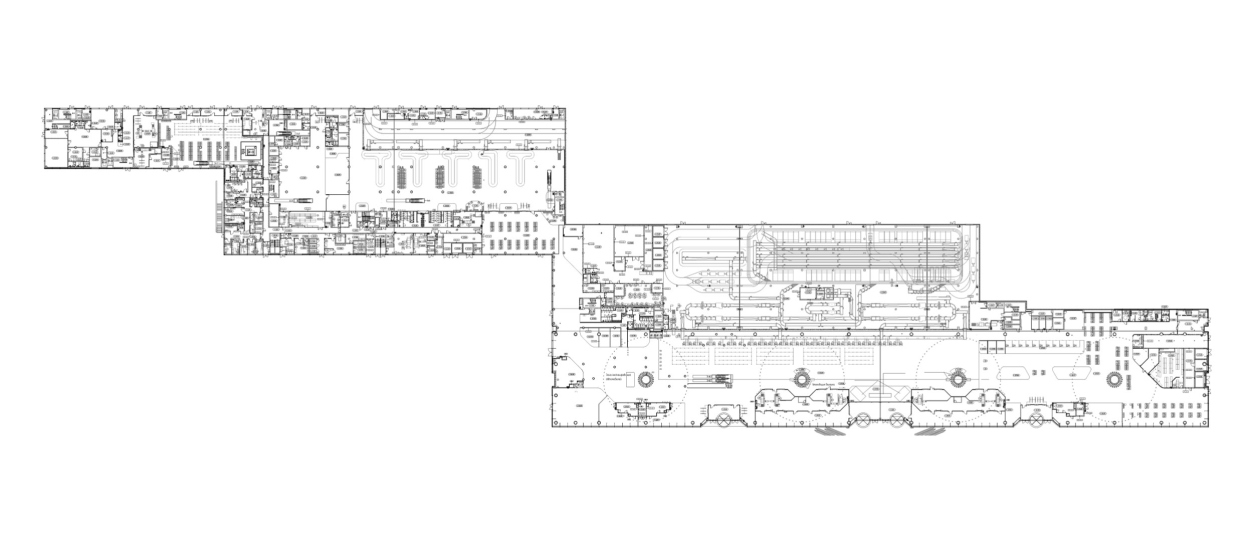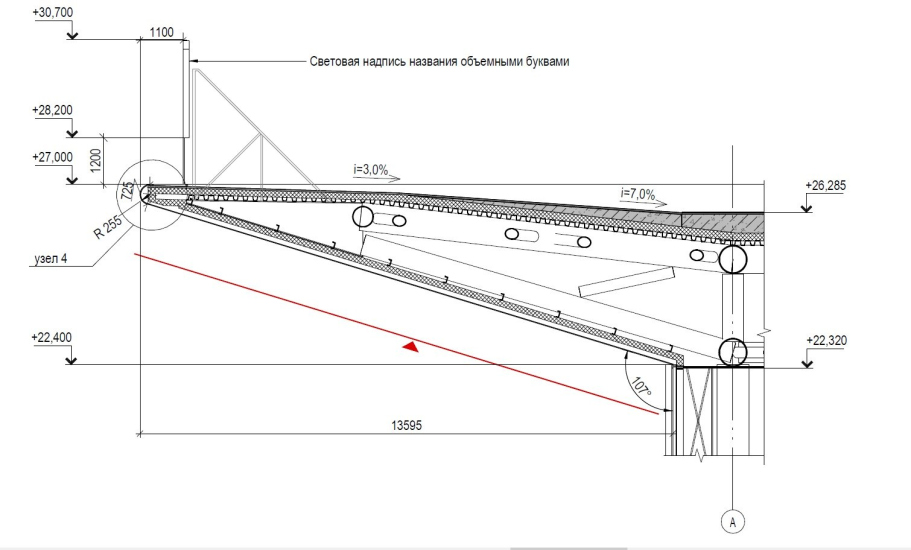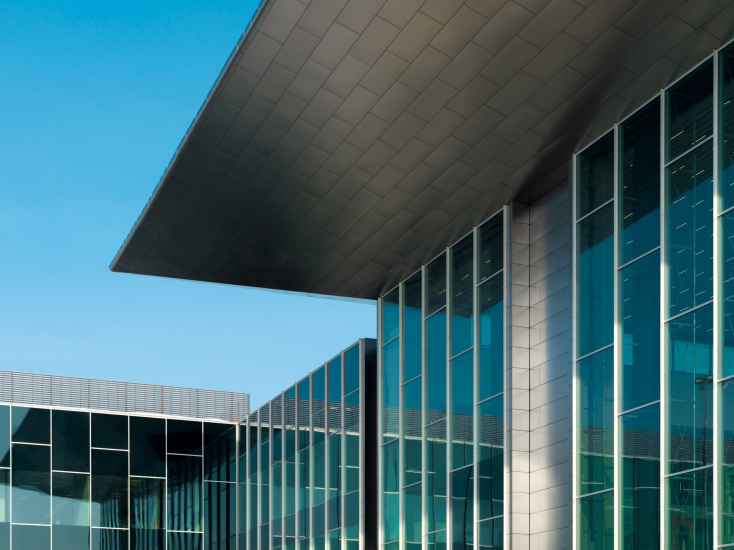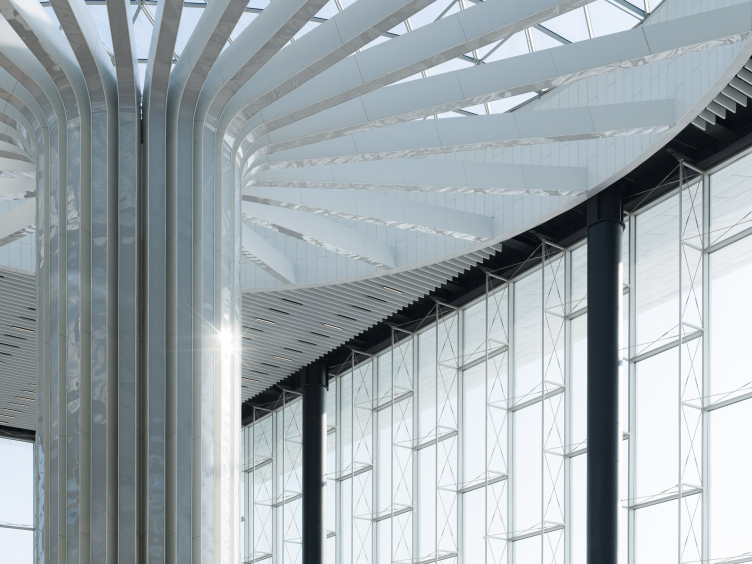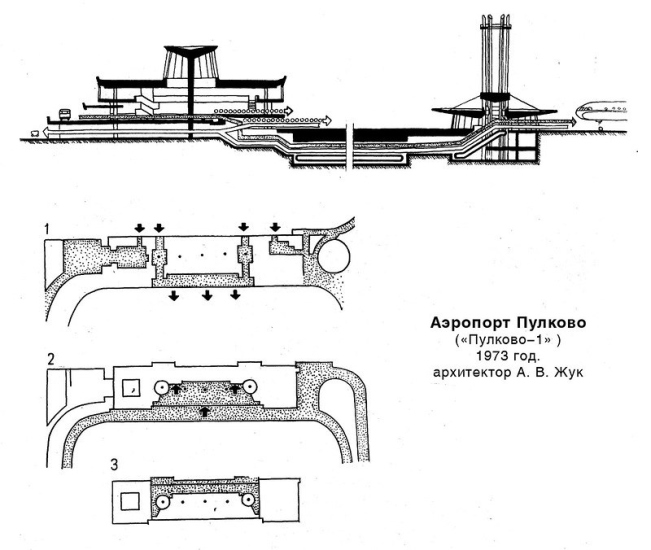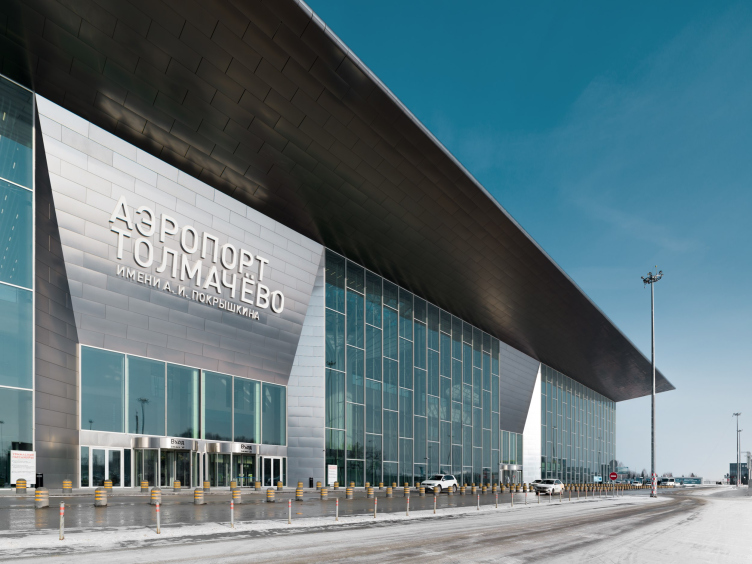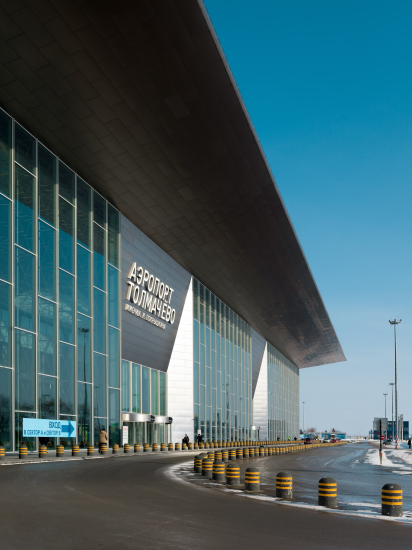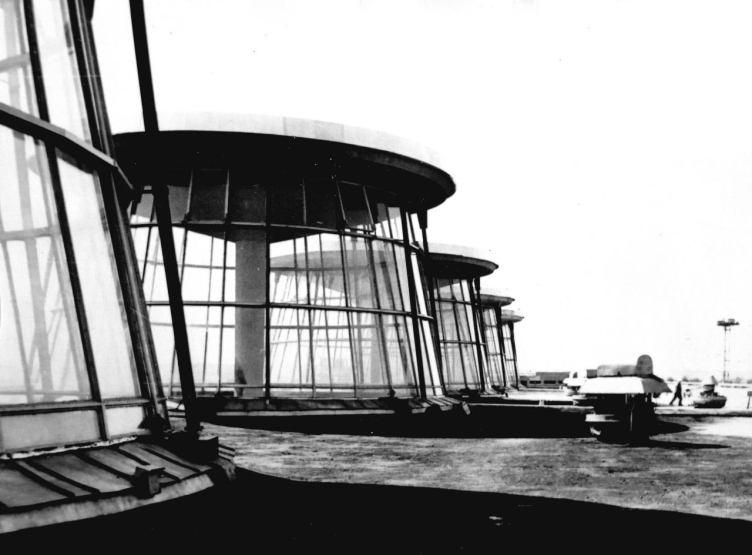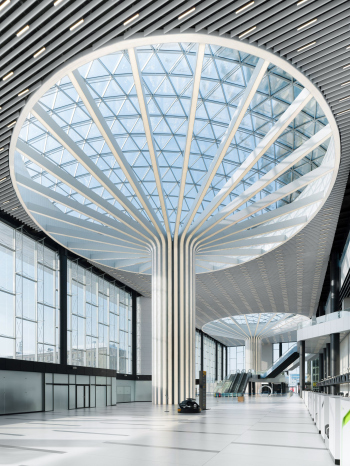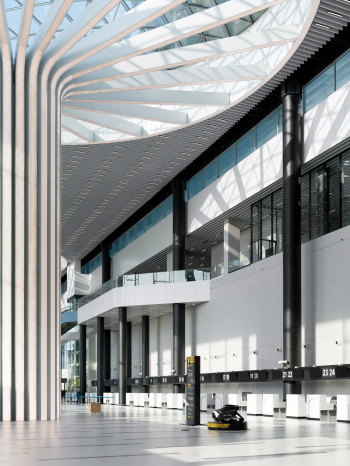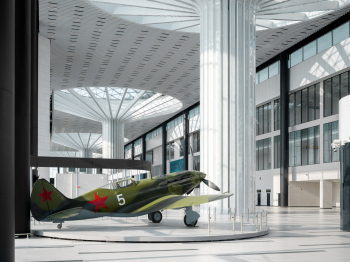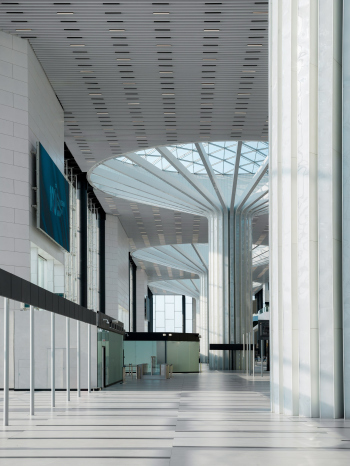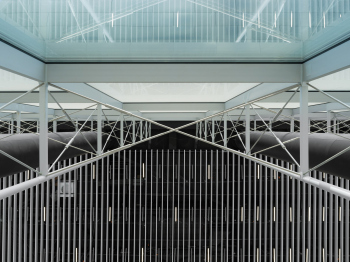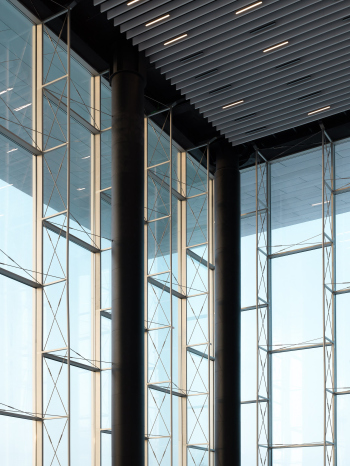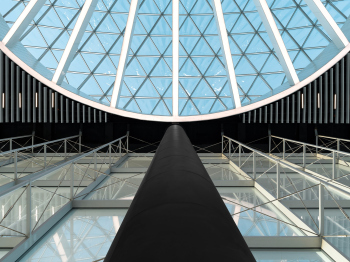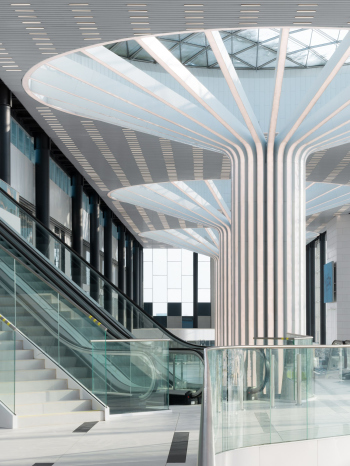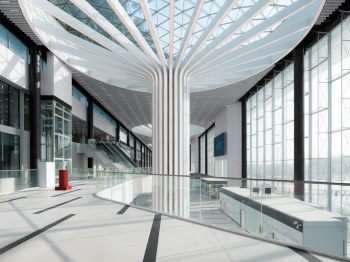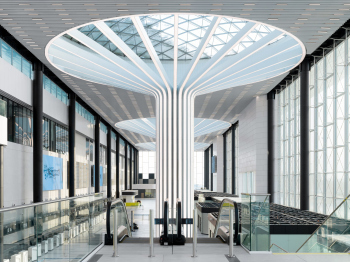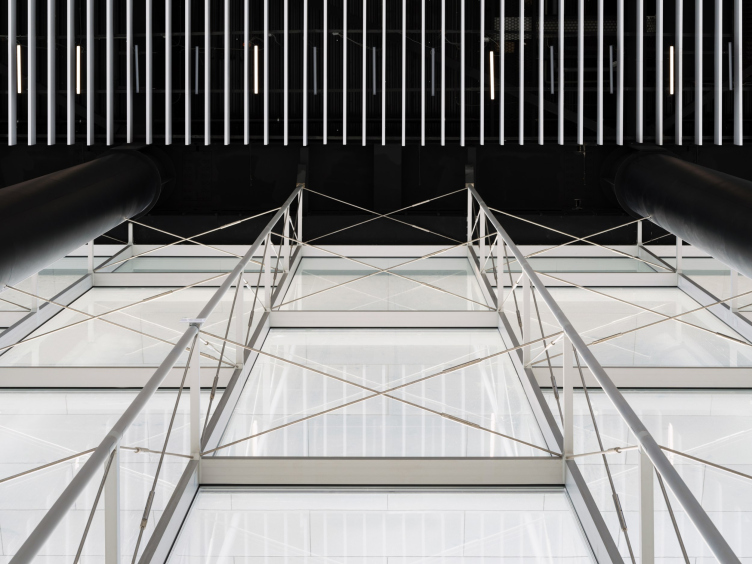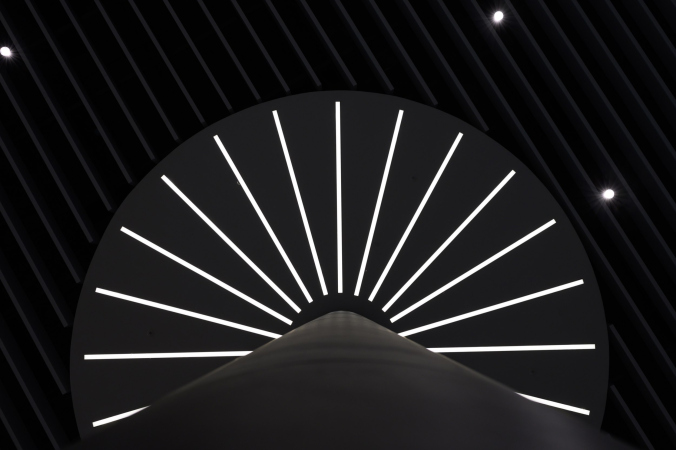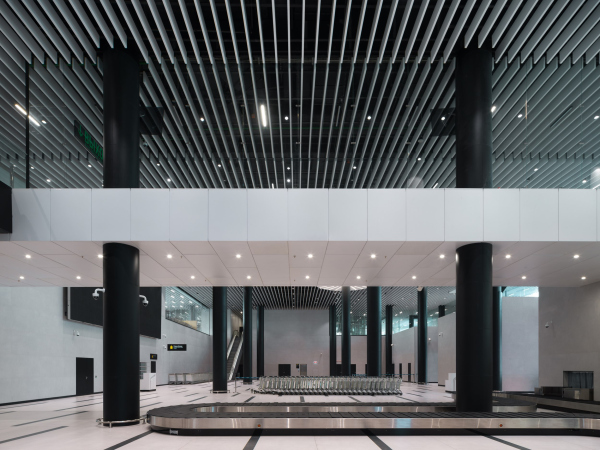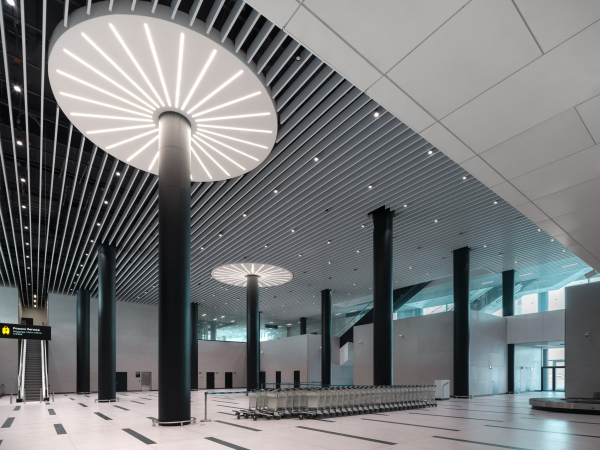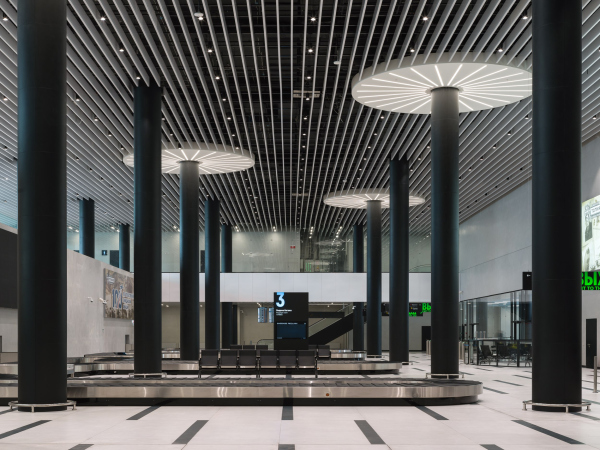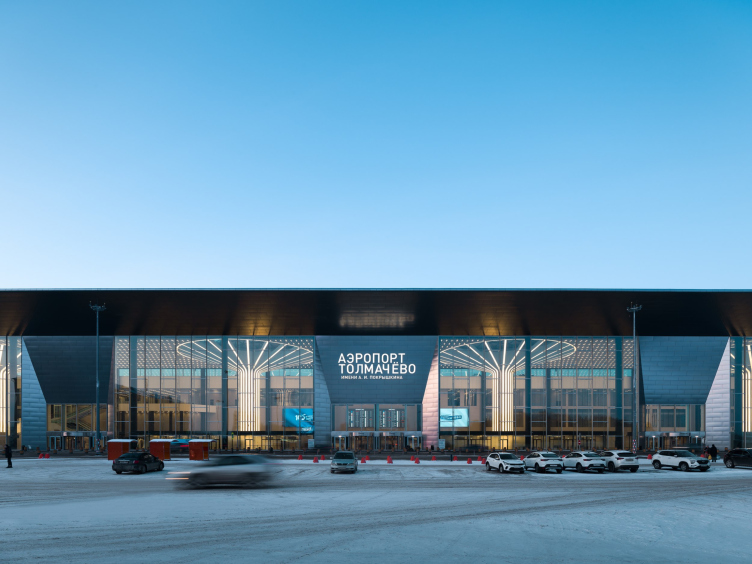Interestingly, both for the head of the architects’ team, Chief Architect of Moscow Sergey Kuznetsov, and for the authors of the architectural solution – Sergey Tchoban and Igor Chlenov – Tolmachevo is the first implemented airport project, although air terminals have appeared in SPEECH’s portfolio before, which makes the result all the more exciting. First things first, however.
Tolmachevo Airport, Terminal C
Copyright: Photograph © Dmitry Chebanenko / provided by SPEECH
The current terminal should become the beginning of the reconstruction of the international airport in Novosibirsk, it is a kind of “first portent”. It is planned to rebuild all the existing buildings in the future. Until the reconstruction is completed, the new Terminal C will work for domestic airlines, while the neighboring Terminal B to the east will continue to function as an international terminal.
Terminal C is located on a new site; it “stepped forward” on the square in front of the existing airport complex, taking on the role of the front facade of Tolmachevo.
There are such projects that are usually represented by numbers; they are usually very noticeable, with a prefix of “mega-“, and Tolmachevo Airport is definitely one of them. The height of the columns is about 30 meters, the diameter of their trunk is 5 m; the diameter of the glass domes is 32 m. The height of the ceiling truss is 1.5 meters. The canopy overhang is 11 meters.
The specifics of the architectural solution, as we know, are affected by scale and size, but not always directly. In this case, the luminous umbrella columns as tall as a nine-story building certainly make an impression.
The columns make an impression when they glow from within through a stained glass window – a giant display case deliberately devoid of additional illumination – like some kind of energy rods.
Tolmachevo Airport, Terminal C
Copyright: Photograph © Dmitry Chebanenko / provided by SPEECH
And they make an impression when the backlighting is off and the columns “bathe” in daylight, abundantly let in by the glass walls on three sides and the domes above.
The columns are amazing: their sheer scale, their “striped” structure, and their position in the space – they seem to occupy the whole of it, but they do not clutter it at all. They are both a part of the building and at the same time an exhibit – a glass cover with an openwork, deliberately thin cable-stayed structure was built for them – in order to show them, which seems quite justified.
Tolmachevo Airport, Terminal C
Copyright: Photograph © Dmitry Chebanenko / provided by SPEECH
Tolmachevo Airport, Terminal C
Copyright: Photograph © Dmitry Chebanenko / provided by SPEECH
Another issue related to the first one has to do with the proportions of the glass “casing”. The length of the glass case is 300 m, width 60 m with the canopy and about 40 m without it. That is, the proportions of the plan inside are practically 1 x 7.5, the front volume being very long.
As for airport terminal buildings in general, they can be almost square or, on the contrary, elongated. The latter is explained by the fact that a long building allows more airplanes to be docked to it. If we look at the plan of St. Petersburg’s Pulkovo, we can see that Grimshaw’s terminal is square, while Alexander Zhuk’s Pulkovo-1 terminal, on the other hand, is long, with not just four but five domes. This is important in this context, because Sergey Tchoban calls Pulkovo-1 the prototype of the Tolmachevo terminal and speaks of intentional parallels with the architecture of “classical” modernism.
Sergey Tchoban
It is now common to design airports with fluid, non-linear forms – it is one of the most expensive, but at the same time quite simple and sure-fire ways to achieve a WOW-effect. However, Novosibirsk is a modernist city, largely developed after the Second World War. We remembered Akademgorodok; and also the very first terminal of the 1960s, designed and built in Tolmachevo by Anatoly Volovik. And we decided to follow the path of restrained architecture, regular and rational, appealing to modernist examples, even though this did not exclude a spectacular gesture, which, in my opinion, were our columns.
For me personally, the key prototype was St. Petersburg’s Pulkovo-1 terminal with its skylights. There, the columns support the roofs at the zeniths of the skylights, and then the roof is suspended from them.
In our case, the design is somewhat different: the columns take on part of the weight of the ceiling trusses, and they share the load with the supports on the outer contour. At the same time, they have a constructive meaning and participate in the distribution of bearing forces inside the building. This was important to us.
For me personally, the key prototype was St. Petersburg’s Pulkovo-1 terminal with its skylights. There, the columns support the roofs at the zeniths of the skylights, and then the roof is suspended from them.
In our case, the design is somewhat different: the columns take on part of the weight of the ceiling trusses, and they share the load with the supports on the outer contour. At the same time, they have a constructive meaning and participate in the distribution of bearing forces inside the building. This was important to us.
-
![zooming]()
![zooming]()
The explanation given here immediately makes the exploration of the prototypes of the airport a fascinating thing to do.
Let’s start with the history of Tolmachevo. The first airport was designed by Novosibgrazhdanproekt back in 1963 as an elongated “beam” building with a square entrance volume of the departure lounge, a stained glass window, and a canopy frame. Here you can see both the project and old photos, and here is the most informative view from above. By 2015, the building was replaced by a new domestic terminal, then it was connected to the glass prisms of the neighboring international terminal, built to the east of it in 1997. The result is a very long and slightly “wiggling” facade, designed in a generalized style, somewhat pretentious and not matching the quality of materials.
In addition to Pulkovo, SPEECH architects cite the example of the House of Scientists in Akademgorodok (1966). However, the format of the new terminal’s glazing can also be compared to another building by Anatoly Volovik in Novosibirsk – the Scientific and Technical Library of the Russian Academy of Sciences (thanks to Marina Ignatushko for the tip).
In Tolmachevo, of course, the glazing is of higher quality: structural, Jumbo, 6 x 3 meters, and with thin vertical slats. However, the image of vertical frames with diagonal alternation and at the same time with slopes, are very much resonant with one another. Quote recognized.
Tolmachevo Airport, Terminal CCopyright: Photograph © Dmitry Chebanenko / provided by SPEECH
Project of the passenger hall of Pulkovo-Leningrad airport. Interior. Perspective. Variant. Architects Verbitsky J.N., Zhuk A.V., Vlanin G.M. 1967. USSR. Leningrad. GMI SPbCopyright: Photographed at the exhibition Architekton 2023
The connection to the main prototype – Pulkovo-1 – is even more intriguing. The Leningrad terminal of 1973 is essentially a long parallelepiped with light skylights supported by columns.
And so, at the recent “Arkhitekton” in St. Petersburg, at an exhibition devoted to Leningrad modernism, an unrealized version of the project caught my eye, where the columns of Pulkovo-1, now rather soaring up into the sky in a somewhat orphaned manner, were drawn mushroom-shaped.
Pulkovo-1 Airport. View on the roof during constructionCopyright: citywalls.ru / загружено ИБН
What is more interesting, however, is that when I asked Sergey Tchoban whether this variant was the inspiration for Tolmachevo, he told me that he did not know about it, and that the first time he ever saw this picture was in the exhibition reports. So the synergy between the project and its prototype, at some immanent level, is even stronger, perhaps, than the author himself could have possibly known? We began to check the projects for similarities, and even little-known variants somehow “fell in line”.
But then again, if you look at the succession of skylights of Pulkovo-1 and at the Tolmachevo hall space as a whole, with your eyes half-closed, they do begin to look similar. The skylights seem to have been brought to some orthogonal projection and merged into one parallelepiped, but the meaning remains: transparent walls, light, supports, umbrellas.
Tolmachevo Airport, Terminal CCopyright: Photograph © Dmitry Chebanenko / provided by SPEECH
It’s not about repetition or quoting, of course, but about being deliberately in line with a certain context.
Mushroom columns are popular in 20th century architecture, and, interestingly, they were used even before modernism: the form dates back to the Neo-Gothic craze that gave the world the fan vault, where the supports merge seamlessly with the ceiling – and at the same time, its development is based on experiments with reinforced concrete technology that only became available a hundred or more years ago. Since then, mushroom-shaped columns, which allow you to free up space and give the ceiling a spectacular plasticity, would be seen here and there. Not to go too far, we can remember yet another project by Sergey Tchoban – the EDGE office building in Berlin, where different-sized wooden “mushrooms”, also plate-like, support the staircases in the atrium space. In that building, by the way, both the shape and the abundance of daylight play a big role, just like they do in Tolmachevo. Airports with similar ideas are also known – for example, in the 2nd terminal of Chhatrapati airport in Mumbai, built according to the SOM project in 2014, mushroom-shaped columns are used, yet of the flexible, mesh-like type. There is no point in talking about borrowings here – rather, we are dealing with a set of ways of organizing large space, common and still perfected in the XX-XXI centuries. In Tolmachevo, the SPEECH architects proposed a version of their own.
Meanwhile, the allusions are not the main thing – they simply add flavor by binding the building with strings of local and other meanings.
And the main thing here, besides brevity, is the abundance of light.
The artificial light of the columns in space is rather akin to some phenomenon of atomic physics, whose dynamics is connected not with the movement accessible to the eye, but with the internal tension of the fields –Akademgorodok, which is located nearby, definitely made its presence known, however indirectly.

And there is plenty of natural light too. A large stained glass window in a modern terminal building is rather a norm, but here we can see it not on just one, but on three sides, and the columns visually “open up” the ceiling, pushing its opaque surface open, revealing the sky in domes. The umbrellas can be compared to the fingers of a hand – only there are a lot of them and they are thin and symmetrical.
In addition, it is important that the building is technologically advanced. The surfaces of the domes, made up of triangles of different formats, and the thin cables of the main stained-glass walls were developed by the company Nesushchie Sistemy (“Bearing Systems”), founded in Novosibirsk and known for having built the first building with non-linear glass facades in the Russian Federation already in 2011, and also for having built the “glass tree bark” of the hall in Zaryadye.
Other technically advanced solutions include the canopy with a large overhang, the ceiling truss, the load distribution between the main “tree” columns and the additional supports that were needed along the glass facades. But there are not many of them, they are tall and thin and not very visible.
Tolmachevo Airport, Terminal CCopyright: Photograph © Dmitry Chebanenko / provided by SPEECH
Meanwhile, there are no “Guinness Book records” here – it’s more about the fact that everything is done at a good level of modern construction: the stretches are thin, the seams of the metal cladding of the portals and the canopy are also thin, they don’t catch the eye, and the steel cassettes themselves are covered with matting varnish so that they shine not too much, but moderately. A certain gentleman’s set of quality, maybe a gloss, not supernatural, but, let’s say, “Metropolitan”. I cannot resist the temptation to say: the way it is supposed to be in the capital of Siberia. After all, after the reconstruction is completed, Tolmachevo will indeed become the largest regional airport.
If the entrance hall is dominated by white color and light – there is an inversion inside. The screening and baggage claim space, as usual, is somewhat simpler and black is either more abundant in it, or it divides the powers with white roughly in half.
Visual “bridges” with the main hall are also provided: round thin fusts of columns remind of supports on the contour, and “daisies” of the lamps embedded in the ceiling unambiguously look like “younger brothers” of the mushroom- shaped columns.
Tolmachevo Airport, Terminal CCopyright: Photograph © Dmitry Chebanenko / provided by SPEECH
However, the most interesting and informative view is from the outside, i.e. from the square. It defines the building’s place in the complex.
It is from here that the whole driving idea can be best appreciated: the luminous “trees”, a kind of Telperions in a casing of transparent and metallic planes. Retrofuturism at its finest: full of meanings, but modern, and WOW-laconic.
It is, in fact, not at all an easy task to make a building both as simple as do-re-mi, and addictively exciting.
Now, wait a minute! Isn’t this a portico?
A giant glowing portico encased in a sheath! Or, perhaps, a stoa, a public gallery from Ancient Greece! It comes forward, forms a representative facade of the airport, declares its ambitions calmly and confidently, marks the entrance not without Hellenistic pathos, as if telling us: I am in charge here, I have been here, in a sense, always. Like the Library of Celsus – whether there is a library or not, the façade is beautiful.
How did it happen? Initially, we were after the simplicity of modernism, but we ended up with a key element of classical architecture?
Well, yes, but not quite. First of all, functionally, the airport entrance hall is a public space for those entering the airport, and it has long since become a place of representation, designed to welcome and impress anyone, to present the airport in all its glory. The portico has the same role, and the row of columns, into which the entrance space has been transformed here, declares this with great magnitude. We are definitely entering somewhere, ready to be transported from Point A to Point B, and the space unequivocally tells us so. Not everyone may understand this but it doesn’t matter; I don’t think everyone understood the meaning of the Library of Celsus either.
Secondly, already in the 1970s, modernism began to search for points of contact with cultural history in the broadest sense, and the main condition of the search was the non-obviousness of the probable quotation, its translation to the level of innuendo. In Tolmachevo, I think we are witnessing a quite successful attempt to return to the same search, as the technology makes its giant leaps.
Which makes the project a really good work with scale and meaning: because when we look closely we see and feel one thing, but when we go outside we see another. However, the most important statement – the almost perfect image of a large airport, the “portico-portal” – is read from afar. It is only then that one realizes that it is about a new beginning.
Firm:SPEECH http://www.speech.su Headlines nowInverted Fortress This year, there has been no shortage of intriguing architectural ideas around the Omsk airport. The project developed by the architectural company KPLN appeals to Omsk’s history as a wooden fortress that it was back in the day, but transforms the concept of a fortress beyond recognition: it “shaves off” the conical ends of “wooden logs”, then enlarges them, and then flips them over. The result is a hypostyle – a forest of conical columns on point supports, with skylights on top.The Paradox of the Temporary The concept of the Russian pavilion for EXPO 2025 in Osaka, proposed by the Wowhaus architects, is the last of the six projects we gathered from the 2022 competition. It is again worth noting that the results of this competition were not finalized due to the cancellation of Russia’s participation in World Expo 2025. It should be mentioned that Wowhaus created three versions for this competition, but only one is being presented, and it can’t be said that this version is thoroughly developed – rather, it is done in the spirit of a “student assignment”. Nevertheless, the project is interesting in its paradoxical nature: the architects emphasized the temporary character of the pavilion, and in its bubble-like forms sought to reflect the paradoxes of space and time.The Forum of Time The competition project for the Russian Pavilion at EXPO 2025 in Osaka designed by Aleksey Orlov and Arena Project Institute consists of cones and conical funnels connected into a non-trivial composition, where one can feel the hand of architects who have worked extensively with stadiums and other sports facilities. It’s very interesting to delve into its logic, structurally built on the theme of clocks, hourglasses and even sundials. Additionally, the architects have turned the exhibition pavilion into a series of interconnected amphitheaters, which is also highly relevant for world exhibitions. We are reminding you that the competition results were never announced.Mirrors Everywhere The project by Sergey Nebotov, Anastasia Gritskova, and the architectural company “Novoe” was created for the Russian pavilion at EXPO 2025, but within the framework of another competition, which, as we learned, took place even earlier, in 2021. At that time, the competition theme was “digital twins”, and there was minimal time for work, so the project, according to the architect himself, was more of a “student assignment”. Nevertheless, this project is interesting for its plan bordering on similarity with Baroque projects and the emblem of the exhibition, as well as its diverse and comprehensive reflectiveness.The Steppe Is Full of Beauty and Freedom The goal of the exhibition “Dikoe Pole” (“Wild Field”) at the State Historical Museum was to move away from the archaeological listing of valuable items and to create an image of the steppe and nomads that was multidirectional and emotional – in other words, artistic. To achieve this goal, it was important to include works of contemporary art. One such work is the scenography of the exhibition space developed by CHART studio.The Snowstorm Fish The next project from the unfinished competition for the Russian Pavilion at EXPO 2025, which will be held in Osaka, Japan, is by Dashi Namdakov and Parsec Architects. The pavilion describes itself as an “architectural/sculptural” one, with its shape clearly reminiscent of abstract sculpture of the 1970s. It complements its program with a meditative hall named “Mendeleev’s Dreams”, and offers its visitors to slide from its roof at the end of the tour.The Mirror of Your Soul We continue to publish projects from the competition for the design of the Russian Pavilion at EXPO in Osaka 2025. We are reminding you that the results of the competition have not been announced, and hardly will ever be. The pavilion designed by ASADOV Architects combines a forest log cabin, the image of a hyper transition, and sculptures made of glowing threads – it focuses primarily on the scenography of the exhibition, which the pavilion builds sequentially like a string of impressions, dedicating it to the paradoxes of the Russian soul.Part of the Ideal In 2025, another World Expo will take place in Osaka, Japan, in which Russia will not participate. However, a competition for the Russian pavilion was indeed held, with six projects participating. The results were never announced as Russia’s participation was canceled; the competition has no winners. Nevertheless, Expo pavilion projects are typically designed for a bold and interesting architectural statement, so we’ve gathered all the six projects and will be publishing articles about them in random order. The first one is the project by Vladimir Plotkin and Reserve Union, which is distinguished by the clarity of its stereometric shape, the boldness of its structure, and the multiplicity of possible interpretations.The Fortress by the River ASADOV Architects have developed a concept for a new residential district in the center of Kemerovo. To combat the harsh climate and monotonous everyday life, the architects proposed a block type of development with dominant towers, good insolation, facades detailed at eye level, and event programming.In the Rhombus Grid Construction has begun on the building of the OMK (United Metallurgical Company) Corporate University in Nizhny Novgorod’s town of Vyksa, designed by Ostozhenka Architects. The most interesting aspect of the project is how the architects immersed it in the context: “extracting” a diagonal motif from the planning grid of Vyksa, they aligned the building, the square, and the park to match it. A truly masterful work with urban planning context on several different levels of perception has long since become the signature technique of Ostozhenka.Generational Connection Another modern estate, designed by Roman Leonidov, is located in the Moscow region and brings together three generations of one family under one roof. To fit on a narrow plot without depriving anyone of personal space, the architects opted for a zigzag plan. The main volume in the house structure is accentuated by mezzanines with a reverse-sloped roof and ceilings featuring exposed beams.Three Dimensions of the City We began to delve into the project by Sergey Skuratov, the residential complex “Depo” in Minsk, located at Victory Square, and it fascinated us completely. The project has at least several dimensions to it: historical – at some point, the developer decided to discontinue further collaboration with Sergey Skuratov Architects, but the concept was approved, and its implementation continues, mostly in accordance with the proposed ideas. The spatial and urban planning dimension – the architects both argue with the city and play along with it, deciphering nuances, and finding axes. And, finally, the tactile dimension – the constructed buildings also have their own intriguing features. Thus, this article also has two parts: it dwells on what has been built and what was conceivedNew “Flight” Architects from “Mezonproject” have developed a project for the reconstruction of the regional youth center “Polyot”(“Flight”) in the city of Oryol. The summer youth center, built back in the late 1970s, will now become year-round and acquire many additional functions.The Yauza Towers In Moscow, there aren’t that many buildings or projects designed by Nikita Yavein and Studio 44. In this article, we present to you the concept of a large multifunctional complex on the Yauza River, located between two parks, featuring a promenade, a crossroads of two pedestrian streets, a highly developed public space, and an original architectural solution. This solution combines a sophisticated, asymmetric façade grid, reminiscent of a game of fifteen puzzle, and bold protrusions of the upper parts of the buildings, completely masking the technical floors and sculpting the complex’s silhouette.Architecture and Leisure Park For the suburban hotel complex, which envisages various formats of leisure, the architectural company T+T Architects proposed several types of accommodation, ranging from the classic “standard” in a common building to a “cave in the hill” and a “house in a tree”. An additional challenge consisted in integrating a few classic-style residences already existing on this territory into the “architectural forest park”.The U-House The Jois complex combines height with terraces, bringing the most expensive apartments from penthouses down to the bottom floors. The powerful iconic image of the U-shaped building is the result of the creative search for a new standard of living in high-rise buildings by the architects of “Genpro”.Black and White In this article, we specifically discuss the interiors of the ATOM Pavilion at VDNKh. Interior design is a crucial component of the overall concept in this case, and precision and meticulous execution were highly important for the architects. Julia Tryaskina, head of UNK interiors, shares some of the developments.The “Snake” Mountain The competition project for the seaside resort complex “Serpentine” combines several typologies: apartments of different classes, villas, and hotel rooms. For each of these typologies, the KPLN architects employ one of the images that are drawn from the natural environment – a serpentine road, a mountain stream, and rolling waves.Opal from Anna Mons’ Ring The project of a small business center located near Tupolev Plaza and Radio Street proclaims the necessity of modern architecture in a specific area of Moscow commonly known as “Nemetskaya Sloboda” or “German settlement”. It substantiates its thesis with the thoroughness of details, a multitude of proposed and rejected form variants, and even a detailed description of the surrounding area. The project is interesting indeed, and it is even more interesting to see what will come of it.Feed ’Em All A “House of Russian Cuisine” was designed and built by KROST Group at VDNKh for the “Rossiya” exhibition in record-breaking time. The pavilion is masterfully constructed in terms of the standards of modern public catering industry multiplied by the bustling cultural program of the exhibition, and it interprets the stylistically diverse character of VDNKh just as successfully. At the same time, much of its interior design can be traced back to the prototypes of the 1960s – so much so that even scenes from iconic Soviet movies of those years persistently come to mind.The Ensemble at the Mosque OSA prepared a master plan for a district in the southern part of Derbent. The main task of the master plan is to initiate the formation of a modern comfortable environment in this city. The organization of residential areas is subordinated to the city’s spiritual center: depending on the location relative to the cathedral mosque, the houses are distinguished by façade and plastique solutions. The program also includes a “hospitality center”, administrative buildings, an educational cluster, and even an air bridge.Pargolovo Protestantism A Protestant church is being built in St. Petersburg by the project of SLOI architects. One of the main features of the building is a wooden roof with 25-meter spans, which, among other things, forms the interior of the prayer hall. Also, there are other interesting details – we are telling you more about them.The Shape of the Inconceivable The ATOM Pavilion at VDNKh brings to mind a famous maxim of all architects and critics: “You’ve come up with it? Now build it!” You rarely see such a selfless immersion in implementation of the project, and the formidable structural and engineering tasks set by UNK architects to themselves are presented here as an integral and important part of the architectural idea. The challenge matches the obliging status of the place – after all, it is an “exhibition of achievements”, and the pavilion is dedicated to the nuclear energy industry. Let’s take a closer look: from the outside, from the inside, and from the underside too.Rays of the Desert A school for 1750 students is going to be built in Dubai, designed by IND Architects. The architects took into account the local specifics, and proposed a radial layout and spaces, in which the children will be comfortable throughout the day.The Dairy Theme The concept of an office of a cheese-making company, designed for the enclosed area of a dairy factory, at least partially refers to industrial architecture. Perhaps that is why this concept is very simple, which seems the appropriate thing to do here. The building is enlivened by literally a couple of “master strokes”: the turning of the corner accentuates the entrance, and the shade of glass responds to the theme of “milk rivers” from Russian fairy tales.The Road to the Temple Under a grant from the Small Towns Competition, the main street and temple area of the village of Nikolo-Berezovka near Neftekamsk has been improved. A consortium of APRELarchitects and Novaya Zemlya is turning the village into an open-air museum and integrating ruined buildings into public life.Towers Leaning Towards the Sun The three towers of the residential complex “Novodanilovskaya 8” are new and the tallest neighbors of the Danilovsky Manufactory, “Fort”, and “Plaza”, complementing a whole cluster of modern buildings designed by renowned masters. At the same time, the towers are unique for this setting – they are residential, they are the tallest ones here, and they are located on a challenging site. In this article, we explore how architects Andrey Romanov and Ekaterina Kuznetsova tackled this far-from-trivial task.In the spirit of ROSTA posters The new Rostselmash tractor factory, conceptualized by ASADOV Architects, is currently being completed in Rostov-on-Don. References to the Soviet architecture of the 1920’s and 1960’s resonate with the mission and strategic importance of the enterprise, and are also in line with the client’s wish: to pay homage to Rostov’s constructivism.The Northern Thebaid The central part of Ferapontovo village, adjacent to the famous monastery with frescoes by Dionisy, has been improved according to the project by APRELarchitects. Now the place offers basic services for tourists, as well as a place for the villagers’ leisure.Brilliant Production The architects from London-based MOST Architecture have designed the space for the high-tech production of Charge Cars, a high-performance production facility for high-speed electric cars that are assembled in the shell of legendary Ford Mustangs. The founders of both the company and the car assembly startup are Russians who were educated in their home country.





